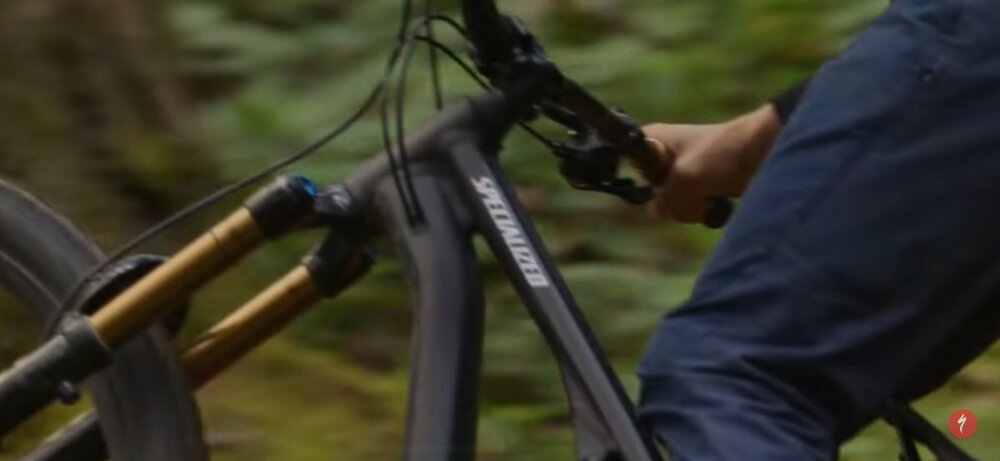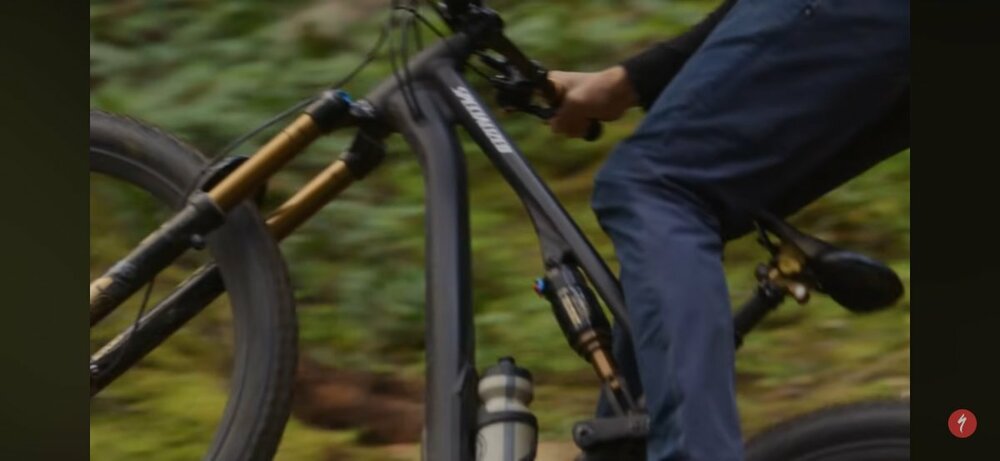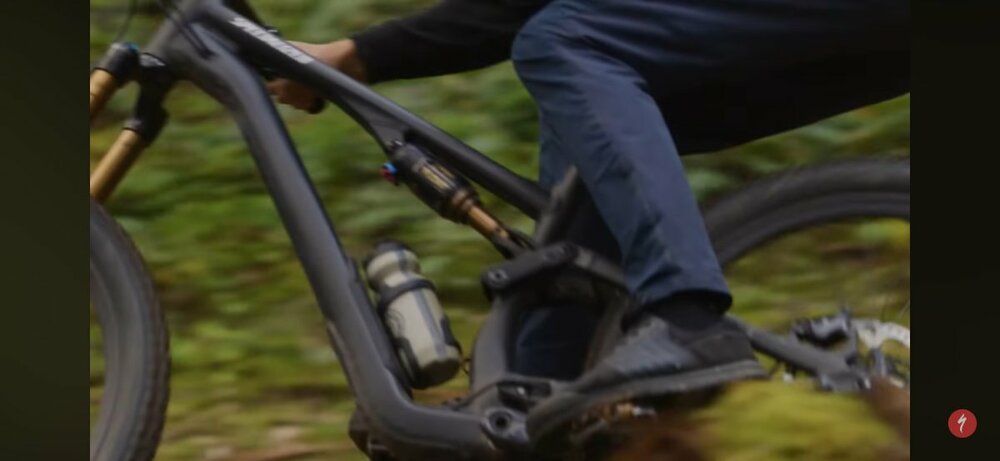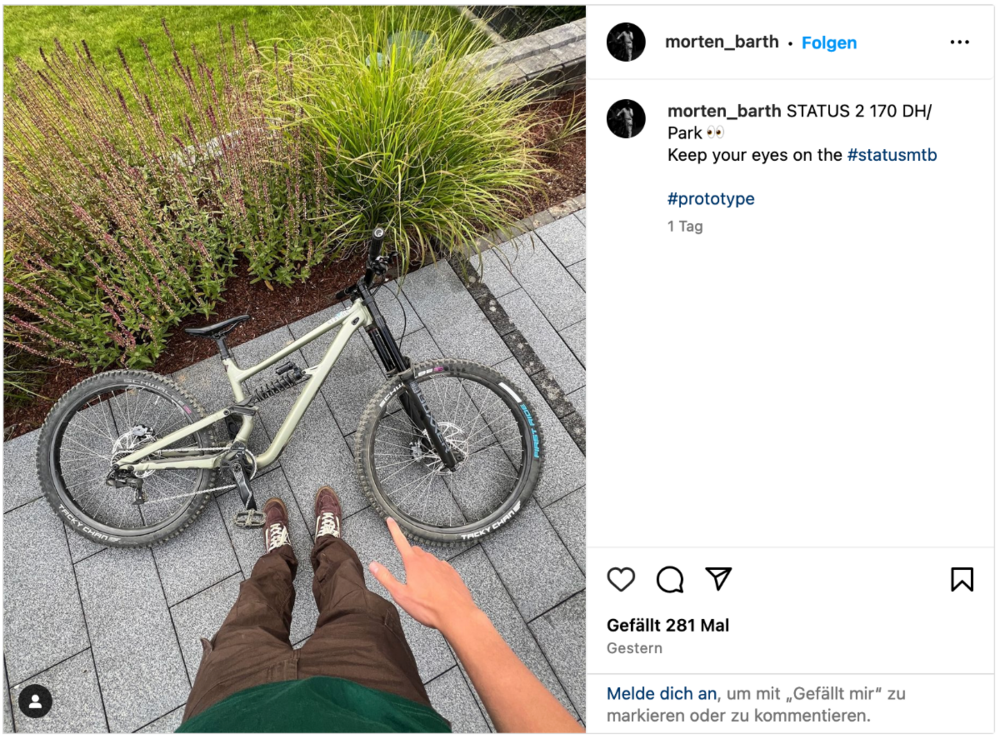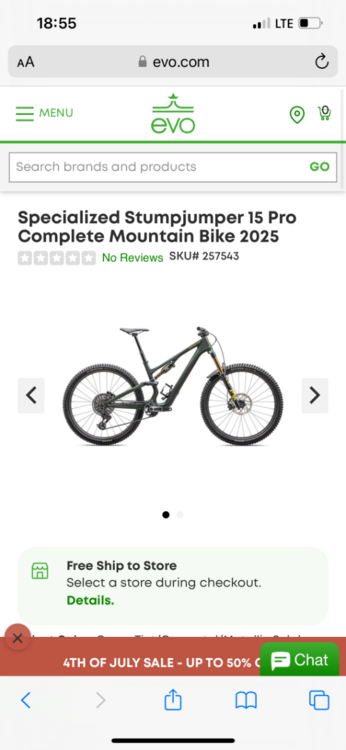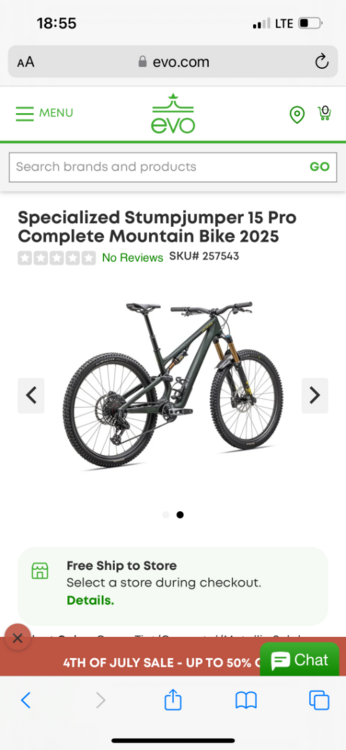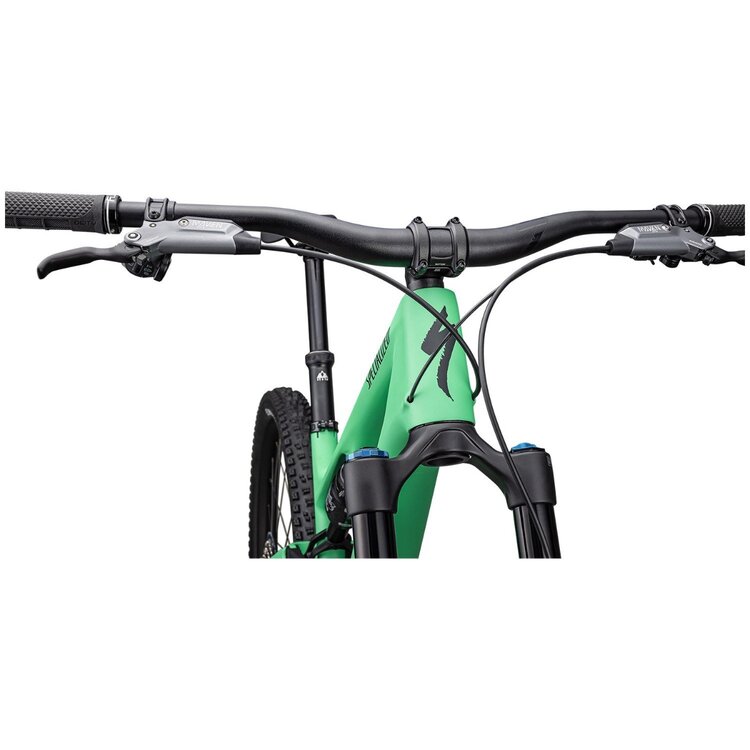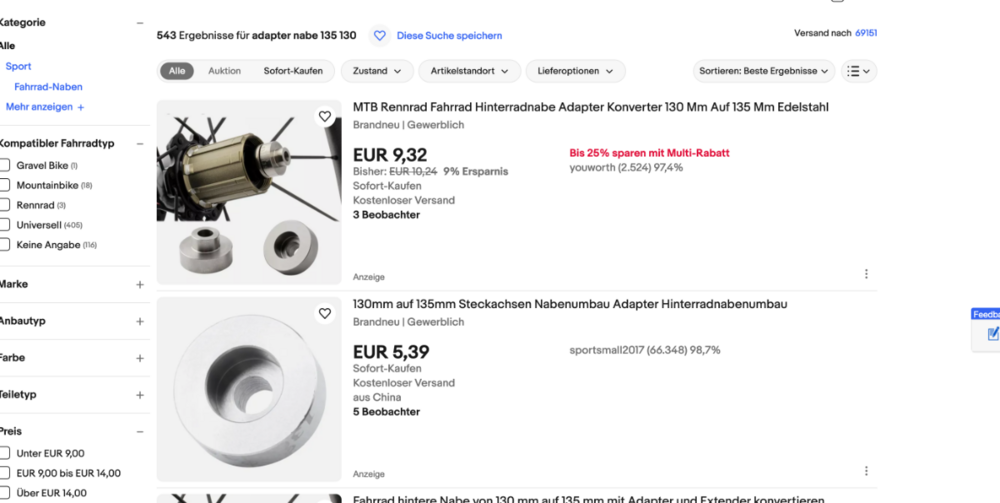-
Posts
502 -
Joined
-
Last visited
-
Days Won
29
Content Type
Profiles
Forums
Events
Everything posted by Ben
-
Vielleicht kann der Freundliche mit einer Auskunft dazu helfen. Konnte es online nicht finden. Stimmt, oben ist der falsche Link.
-
Vielleicht hilft dir die Auflistung der Modelljahre und der jeweiligen Ausstattungsmerkmale: Turbo Levo Comp Alloy 2020 Rahmen: M5 Premium Aluminum Motor: Specialized 2.1, 565W nominal Akku: 500Wh Gabel: RockShox Revelation RC, 150mm Dämpfer: RockShox Deluxe Select+ RT Schaltung: SRAM NX Eagle, 12-Gang Bremsen: SRAM Guide RE, 4-Kolben Laufräder: Specialized 29" Aluminium, tubeless-ready Turbo Levo Comp Alloy 2021 Rahmen: M5 Premium Aluminum Motor: Specialized 2.1, 565W nominal Akku: 700Wh Gabel: Fox Float 36 Rhythm, 160mm Dämpfer: Fox Float DPS Performance Schaltung: SRAM NX Eagle, 12-Gang Bremsen: SRAM Guide RE, 4-Kolben Laufräder: Roval Traverse 29", tubeless-ready Turbo Levo Comp Alloy 2022 Rahmen: M5 Premium Aluminum Motor: Specialized 2.2, 90 Nm Drehmoment Akku: 700Wh Gabel: Fox Float 36 Rhythm, 160mm Dämpfer: Fox Float DPS Performance Schaltung: SRAM GX Eagle, 12-Gang Bremsen: SRAM Code R, 4-Kolben Laufräder: Roval Traverse 29", tubeless-ready Turbo Levo Comp Alloy 2023 Rahmen: M5 Premium Aluminum Motor: Specialized 2.2, 90 Nm Drehmoment Akku: 700Wh Gabel: Fox Float 38 Performance, 160mm Dämpfer: Fox Float X Performance Schaltung: SRAM GX Eagle, 12-Gang Bremsen: SRAM Code R, 4-Kolben Laufräder: Roval Traverse 29", tubeless-ready Turbo Levo Comp Alloy 2024 Rahmen: M5 Premium Aluminum Motor: Specialized 2.2, 90 Nm Drehmoment Akku: 700Wh Gabel: RockShox Lyrik Select, 160mm Dämpfer: RockShox Super Deluxe Select+ Schaltung: SRAM GX Eagle, 12-Gang Bremsen: SRAM Code RSC, 4-Kolben Laufräder: Roval Traverse Alloy 29", tubeless-ready Hier hast du noch eine Auflistung der Änderungen: Motor: Seit 2022 wird der Specialized 2.2 Motor verwendet, der 90 Nm Drehmoment liefert. Akku: Ab 2021 ist ein 700Wh Akku Standard. Schaltung: Die Modelle sind mit SRAM 12-Gang-Schaltungen ausgestattet, wobei die GX Eagle seit 2022 Standard ist. Bremsen: Seit 2022 werden SRAM Code R Bremsen verwendet, ab 2024 Code RSC.
-
Hast du am GX Bike eine 52er Kassette und am NX eine 50er? Je größer die Zähnezahl im 1. Gang desto höher die Zugspannung. Wenn es über die ganze Bandbreite auffällt, dann muss es quasi die Feder im Schaltwerk sein. Vorausgesetzt alle Innenzüge und Außenhüllen sind frisch und i.O.
-
Specialized bietet auch ein 6A Schnellladegerät an, das die Ladezeit erheblich verkürzt. Mit einem 6A Ladegerät kann die Ladezeit für einen 700 Wh-Akku auf etwa 2 bis 3 Stunden reduziert werden. https://www.specialized.com/de/de/turbo-ladegert/p/157250?searchText=98916-5640&color=232046-157250 Turbo-Ladegerät 170,00 € Lade deinen Turbo-Akku mit diesem leistungsstarken Li-Ionen-Ladegerät auf. Li-Ionen-Ladegerät Ausgang: 42V4A Das kompakte Design liefert enorm viel Leistung. Ausgestattet mit Rosenberger-Stecker und Lichtanzeige des Ladestatus.
-
Hi Michael, sicherlich über die Rahmennummer. Geht es denn dir um das Produktionsdatum? Wenn du generell nach gekaufter Ausstattung und Farbe gehst, dann wäre es doch eindeutig zuzuordnen.
-

Das neue Stumpjumper 2025 - Stumpjumper 15
Ben replied to Ben's topic in Specialized Stumpjumper und Stumpjumper Evo
Das hat nicht lange gedauert. Hier sind die Bilder von Matt Hunters Stumpjumper Alu Racebike: -

Das neue Stumpjumper 2025 - Stumpjumper 15
Ben replied to Ben's topic in Specialized Stumpjumper und Stumpjumper Evo
In einem Produktvideo von Specialized sieht man ab 11:50 Minuten ein Stumpjumper aus Alu mit Leitungsöffnungen im Rahmen. So kann es was werden, Specialized! -
Es gibt spannende Neuigkeiten aus dem Hause Specialized. Laut einem lokalen Händler steht die Veröffentlichung des neuen Specialized Status unmittelbar bevor. In rund drei Wochen sollen zwei neue Modelle dieses beliebten Bikes auf den Markt kommen: ein Modell mit 140 mm Federweg und ein weiteres mit beeindruckenden 170 mm Federweg. Die beiden Modelle im Detail Specialized Status 140mm: Dieses Modell richtet sich an dich, wenn du ein agiles und vielseitiges Bike suchst. Mit 140 mm Federweg eignet es sich hervorragend für Trail-Riding und All-Mountain-Abenteuer. Die Geometrie und das Fahrverhalten sind darauf ausgelegt, sowohl bergauf als auch bergab eine exzellente Performance zu liefern. Specialized Status 170mm: Das zweite Modell verspricht besonders viel Spannung. Mit 170 mm Federweg und der Kompatibilität für eine Doppelbrücken-Gabel (Dual Crown) richtet es sich an dich, wenn du ein Gravity-Sport-Liebhaber bist. Dieses Bike ist darauf ausgelegt, selbst die härtesten Downhill-Strecken zu meistern und bietet eine maximale Kontrolle und Stabilität auch bei hohen Geschwindigkeiten und großen Sprüngen. Dual Crown Kompatibilität: Ein Game Changer Besonders interessant ist die Möglichkeit, das 170mm-Modell mit einer Doppelbrücken-Gabel auszustatten. Diese Gabeln, die normalerweise bei reinen Downhill-Bikes zum Einsatz kommen, bieten eine höhere Steifigkeit und bessere Dämpfungseigenschaften. Für dich, wenn du das absolute Maximum an Performance und Kontrolle aus deinem Bike herausholen möchtest, ist dies ein bedeutendes Upgrade. Verfügbarkeit und Erwartungen Die neuen Specialized Status Modelle sollen in etwa drei Wochen erhältlich sein. Die Kombination aus vielseitigem 140mm-Modell und dem robusten 170mm-Modell dürfte eine breite Palette an Fahrern ansprechen – von Trail-Fahrern bis hin zu Downhill-Fanatikern. Specialized hat mit der Status-Serie bereits in der Vergangenheit gezeigt, dass sie wissen, wie man leistungsfähige und spaßige Bikes baut. Mit den neuen Modellen für 2025 scheint der Hersteller diesen Weg konsequent fortzusetzen und setzt dabei erneut auf innovative Features und bewährte Qualität.
- 1 reply
-
- 1
-

-

Das neue Stumpjumper 2025 - Stumpjumper 15
Ben replied to Ben's topic in Specialized Stumpjumper und Stumpjumper Evo
Hier startet die Videosammlung. Den Startschuss markiert Pinkbike: -

Das neue Stumpjumper 2025 - Stumpjumper 15
Ben replied to Ben's topic in Specialized Stumpjumper und Stumpjumper Evo
Hier ist es, das neue Specialized Stumpjumper 15 Pro Complete Mountain Bike 2025 Die Strebe ist weg, die Formsprache geradlinig. Sehr hübsch, mit gefällt es. s1 und s2 sind Mullets, s3 aufwärts sind full 29“. Federweg 160 mm vorne und 145 hinten. und, Achtung, keine(!) Rahmeneingänge für Schaltzüge 😳 -
Kannst auch mal die E Bike Beläge von Galfer probieren: https://www.galferonline.es/Sites/galferonline/paginasPersonalizadas/Modelo4/ArticulosDetalle.aspx?cod=FD455G1652 https://galfer.eu/bike/products/brake-pads/?product_brand=sram&s= Oder Swiss Stop für E Bikes: https://swissstop.com/de/brakepads/discbrakes/disc31/disce/ https://swissstop.com/de/brakepads/discbrakes/disc29/disce/
-
Die sind alle gleich bei den Codes. SRAM Sinter gehen gut, Trickstuff Power hat viel Dampf, verschleißt aber schnell. Galfer hat welche im Programm, aber die waren auch nicht deutlich besser als die vorangenannten. Was dir bei langen Abfahrten helfen kann, sind größere Bremsscheiben. 220er bspw.
-
Unterstützungstufen Einstellen Specialized Mission Control App herunterladen: Installieren Sie die Specialized Mission Control App auf Ihrem Smartphone (verfügbar für iOS und Android). Mit dem Bike verbinden: Öffnen Sie die App. Schalten Sie das Specialized Levo ein. Stellen Sie eine Bluetooth-Verbindung zwischen Ihrem Smartphone und dem Bike her (Anweisungen dazu finden Sie in der App). Unterstützungsstufen anpassen: In der App gehen Sie zu den Einstellungen für die Unterstützung. Sie können die Unterstützung für die drei Stufen (Eco, Trail, Turbo) individuell anpassen. Für eine optimierte Reichweite könnten die Einstellungen wie folgt aussehen: Eco-Modus: 20-30% Unterstützung Trail-Modus: 40-50% Unterstützung Turbo-Modus: 60-70% Unterstützung Diese Werte sind nur Vorschläge. Sie können sie je nach Ihren Bedürfnissen und Fahrgewohnheiten anpassen. Das Ziel ist es, in den unteren Modi möglichst wenig Unterstützung zu nutzen, um die Batterielaufzeit zu maximieren. Speichern der Einstellungen Einstellungen speichern: Nachdem Sie die Unterstützungseinstellungen angepasst haben, speichern Sie diese in der App. Normalerweise gibt es eine "Speichern" oder "Übernehmen"-Schaltfläche. Testfahrt machen: Machen Sie eine Testfahrt, um sicherzustellen, dass die Unterstützung Ihren Anforderungen entspricht. Passen Sie gegebenenfalls die Einstellungen weiter an. Regelmäßige Überprüfung: Überprüfen Sie die Einstellungen regelmäßig und passen Sie sie an, wenn sich Ihre Fahrgewohnheiten ändern oder wenn Sie feststellen, dass die Reichweite nicht optimal ist.
-

Turbo Levo 2022 Motor/Tretlager quietscht
Ben replied to Alex3000's topic in Specialized Levo und Levo SL
Lass hören, ob du was finden konntest. -
Ab sofort erhältlich ist das neue Chisel, das Alu XC Fully für das Modelljahr 2025. https://www.specialized.com/us/en/chisel-comp-shimano/p/4274028?color=5427854-4274028 Sie nennen es Speed Metal, das leichteste, schnellste XC Fully der Welt. Es ist nicht gesichert, was Exciter damit zu tun haben, aber die sind eben Speed Metal. Das Rahmenset geht für US Dollarse 2000 über die Theke, das Gloss Maroon / White mit RS Recon und X Fusion Dämpfer, SRAM Billo-Antrieb für 2600 US$. Es gibt eine Shimano Version für ebenfalls 2600 $, hier werkelt dann eine Deore Gruppe an Antrieb und Bremsen. Das Teuerste ist das Comp Shimano mit Deluxe Select+ und Sid Fahrwerk sowie einem SLX Antrieb. Das Comp: Das Shimano ohne Comp: Der SRAM Aufbau: Das Schönste: das Framekit
-
Es kursieren diese Infomails von Specialized, die ein neues Bike in Aussicht stellen. Vielleicht das Demo oder das Enduro? Stumpjumper Evo?
-

Turbo Levo 2022 Motor/Tretlager quietscht
Ben replied to Alex3000's topic in Specialized Levo und Levo SL
Hi Alex, der 2.2 Motor ist derselbe wie der Brose drive s mag Motor. Dazu könntest du mal schauen, ob es ein passendes Lager gibt, bspw. für die Ausgangswelle, auf die du den Kurbelarm schraubst. Habe auf die Schnelle nur Links in Amiland gefunden, aber du siehst, es gibt Ersatzlager dafür: https://ebikemotorrepair.com/product/brose-s-t-and-s-mag-crankshaft-belt-drive-pulley-bearing-part-no-plb20124/?v=5b61a1b298a0 https://www.ebikemotorcentre.com/product/brose-s-mag-bearing-overhaul-kit-part-no-plb20701mag/ -
Das neue Crux ist seit gestern in Deutschland im Verkauf. Biker Boarder haben es bereits online. https://www.biker-boarder.de/specialized/3093033.html Die Geometrietabelle kommt hier: Das offizielle Specialized Datenblatt zeigt uns alle relevanten Standard und Maße: Rahmen Crux FACT 10r Carbonrahmen: "Functionally Advanced Composite Technology"; je höher der Wert, umso komplexer der Produktionsprozess und leichter ist die Gabel, aber auch teurer Rider-First Engineered™: Um für jede Rahmengröße dieselben Leistungsparamter zu erhalten, muss jede Rahmengröße eigenständig und auf Basis derjenigen Belastungswerte entwickelt werden, die vom jeweiligen Fahrer ausgehen. Das bedeutet auch, dass für jede Rahmengröße alle Rohrdimensionen und die gesamte Faserbelegung auf Basis der gewonnenen Daten ausgewählt werden. Und was bedeutet das für dich? Egal, ob du einen 61 cm oder 49 cm Rahmen fährst, Specialized garantiert dir absolute Leistungsfähigkeit und sichere Beherrschung deines Rades unter anspruchsvollen Bedingungen. Denn letztlich geht es nur um ein Rad…deines. Das ist Rider-First Engineered™. Extra leicht: 825 g FACT 10r Carbon Rahmen. Specialized hat die Erkenntnisse aus der Entwicklung des Aethos Rahmen übernommen und auf das Crux übertragen. Das Ergebnis? Ein Gravel Bike, das traumhaft klettert, über ruppiges Terrain fliegt und dabei weniger als deine volle Trinkflasche wiegt. Vielseitig: Das Crux besitzt 2.1 Zoll bzw. 53 mm Reifenfreiheit bei 47C bzw. 650B Laufradgröße. Mehr Reifenfreiheit bedeutet mehr Möglichkeiten. Genau wie unser Diverge bringt dich das Crux überall hin, und das mit Vollgas. 12 x 142 mm Steckachse Gabel FACT Carbongabel: "Functionally Advanced Composite Technology"; je höher der Wert, umso komplexer der Produktionsprozess und leichter ist die Gabel, aber auch teurer Flat-Mount Bremsaufnahme 12 x 100 mm Steckachse
-
Ich würde an deiner Stelle nur den Ring tauschen. Die alten Speichen kannst du weiterverwenden, die Nippel gehen auch locker ein zweites Mal, sofern die Aufnahmeflächen des Vierkants nicht vernudelt sind. Warum es kaum oder keine 135 mm Felgenbremsräder mehr gibt… hm. Die Zeit der Felgenbremsen ist vorbei, alles ist nur noch Scheibe. Aus gutem Grund. Ist halt ein Standard, der veraltet ist. Kann sein, dass 135 mm ein etwas obskures Maß sind. Das Specialized Amira einer Freundin hat das auch. Da haben wir einfach einen neuen Felgenring eingespeicht. Die gibt es nämlich wohl noch zu kaufen.


